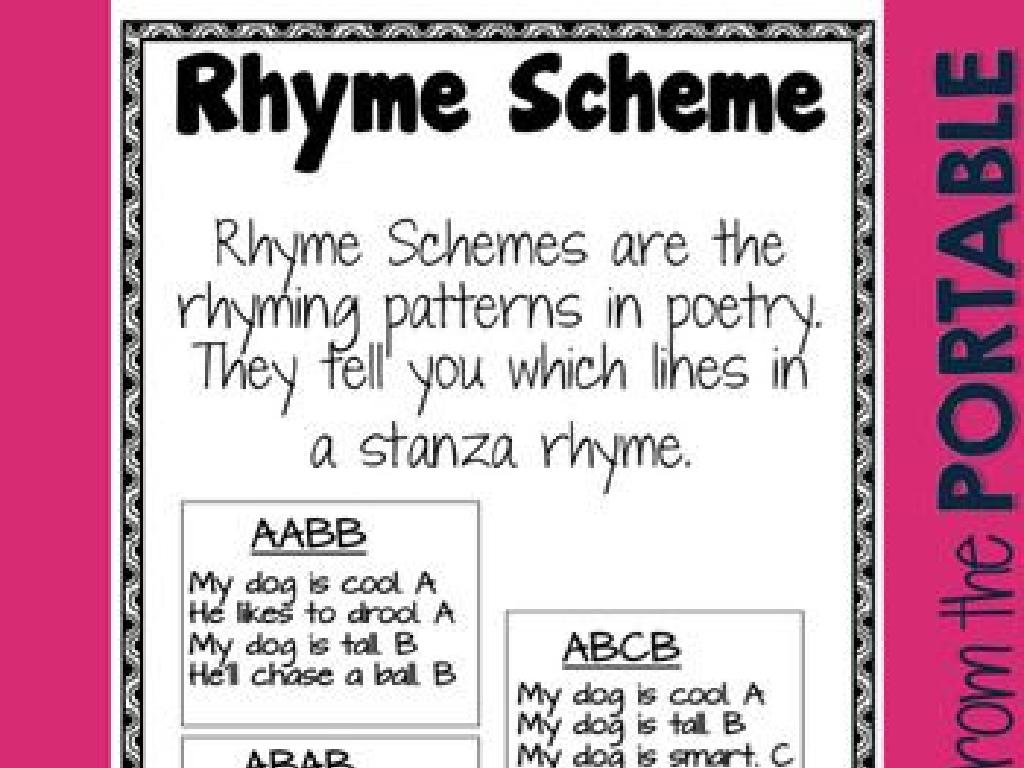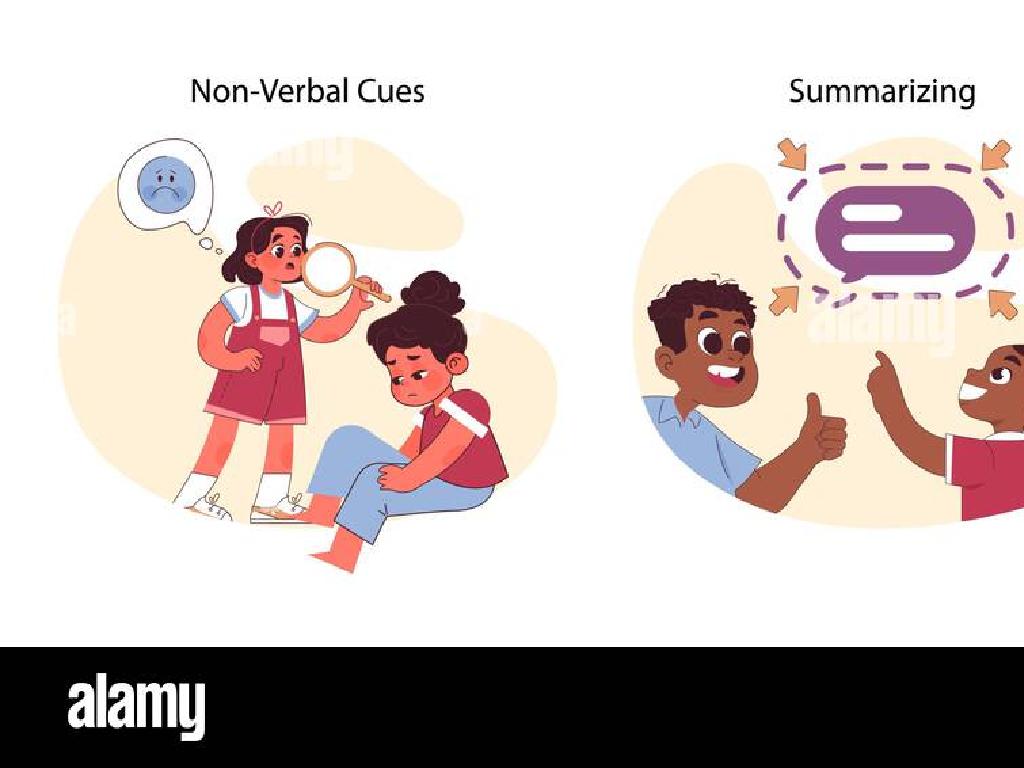Identify Quotients Of Rational Numbers: Word Problems
Subject: Math
Grade: Seventh grade
Topic: Operations With Rational Numbers
Please LOG IN to download the presentation. Access is available to registered users only.
View More Content
Understanding Rational Numbers
– Define rational numbers
– Numbers that can be expressed as a fraction a/b, where a and b are integers and b is not zero.
– Examples of rational numbers
– For instance, 1/2, 3/4, and 5 are all rational numbers.
– Rational numbers in daily life
– Used in cooking, budgeting, and measuring distances.
– Solving word problems
|
This slide introduces the concept of rational numbers, which are any numbers that can be written as a fraction with an integer numerator and a non-zero integer denominator. Provide clear examples to illustrate the concept, such as 1/2 representing half an object or 3/4 representing three quarters of something. Emphasize the prevalence of rational numbers in everyday life, such as in recipes (half a cup of sugar), financial planning (3/4 of a budget spent), or even when measuring distances (5 miles). Conclude by explaining how understanding rational numbers is crucial for solving word problems, which often involve real-life scenarios where these numbers are used. Encourage students to think of additional examples from their daily experiences.
Understanding Quotients in Rational Numbers
– Define the term ‘quotient’
– Quotient is the result of division
– Quotient: division outcome
– When we divide, the answer we get is the quotient
– Components: dividend, divisor
– Dividend ÷ Divisor = Quotient
– Quotient in word problems
– Use quotients to solve real-life problems
|
This slide introduces the concept of quotients within the context of rational numbers. Begin by defining a quotient as the result of dividing one number by another. Emphasize the relationship between the dividend (the number being divided), the divisor (the number by which the dividend is divided), and the quotient (the result of the division). Illustrate with examples, such as dividing a pizza among friends to find out how much each person gets. Encourage students to think of quotients not just as numbers, but as answers to questions involving sharing or grouping in real-life scenarios. In the next class, we will explore how to identify and calculate quotients through word problems, reinforcing the concept with practical applications.
Identifying Quotients of Rational Numbers
– Define quotients with rational numbers
Quotients result from dividing one rational number by another, e.g., 6/3 = 2.
– Solve simple quotient problems
Example: If you have 8/2, how many times does 2 go into 8?
– Tips for accurate quotient identification
Check division by multiplying the quotient by the divisor to get the dividend.
– Practice with word problems
Use real-life scenarios like splitting a bill or dividing a pizza.
|
This slide introduces the concept of finding quotients within the realm of rational numbers, which is a key skill in understanding operations with rational numbers. Start by defining what a quotient is and how it is found by dividing one number by another. Provide simple problems for students to solve, ensuring they understand the process. Offer tips to help them check their work, such as verifying their answer by reversing the operation. Finally, give them word problems that apply to real-life situations to solidify their understanding and make the math more relatable. Encourage students to explain their thought process when solving these problems to enhance their comprehension.
Quotients in Word Problems
– Comprehend the word problem
– Break down the problem
– Divide the problem into manageable steps
– Find the dividend and divisor
– Dividend is what you divide; divisor is what you divide by
– Solve and check your answer
– Use division to solve, then verify with multiplication
|
This slide aims to guide students through the process of solving word problems that involve finding quotients of rational numbers. Start by ensuring students understand the problem by reading it carefully and looking for key information. Teach them to break down the problem into smaller, more manageable parts to avoid feeling overwhelmed. Next, help them identify the dividend (the number being divided) and the divisor (the number by which the dividend is divided). Once they have identified these components, students can solve the problem using division. Encourage them to check their answers by multiplying the quotient by the divisor to see if it equals the dividend. Provide examples and practice problems to reinforce these steps.
Quotient Word Problems with Rational Numbers
– Sharing pizzas among friends
– If 8 friends share 2 pizzas equally, how much pizza does each get?
– Dividing money for a school trip
– $150 is split equally for 5 students. How much does each student get?
– Steps to solve quotient problems
– Understand the problem, identify numbers involved, perform division, and interpret the result.
|
This slide introduces students to the concept of finding quotients through relatable word problems. Start with a scenario where friends share pizzas to illustrate division of a whole into equal parts. Then, use the example of dividing money for a school trip to show division of a quantity into equal shares. Emphasize the steps to solve these problems: understanding what is being asked, identifying the numbers and their relationship, performing the division operation, and interpreting the answer in the context of the problem. Encourage students to visualize the scenarios and relate them to real-life situations. This will help them grasp the concept of quotients in a practical and engaging way.
Quotients of Rational Numbers: Practice
– Solve for the quotient
– Use division to find the quotient of two rational numbers.
– Discover missing numbers
– Given a quotient, work backwards to find the missing divisor or dividend.
– Apply to real-world problems
– Use a real-life problem to see how quotients of rational numbers are used in everyday situations.
– Review and discuss solutions
|
This slide is designed for practice problems to help students apply their knowledge of finding quotients of rational numbers. Problem 1 focuses on calculating the quotient, reinforcing the division process. Problem 2 challenges students to think inversely by finding a missing divisor or dividend when given the quotient. Problem 3 connects classroom learning to the real world, showing practical applications of quotients. Encourage students to work through problems collaboratively and discuss their methods and answers. Provide guidance as needed and use this opportunity to address common misconceptions. Possible activities include peer teaching, group work, or individual practice to cater to different learning styles.
Class Activity: Quotient Quest!
– Engage in group problem solving
– Focus: Quotients from word problems
– Work through complex problems to find the quotient of rational numbers
– Use provided problem cards
– Each group receives a set of cards with word problems
– Discuss solutions on whiteboards
– Share and explain your group’s solutions with the class
|
This activity, Quotient Quest, is designed to help students apply their knowledge of rational numbers to solve complex word problems. Divide the class into small groups and provide each group with problem cards, a whiteboard, and markers. The objective is to identify the quotient in various scenarios, encouraging collaboration and discussion within groups. As students work through the problems, circulate the room to offer guidance and ensure understanding. After solving the problems, each group will present their solutions, explaining their reasoning process. This peer-to-peer learning opportunity reinforces the concept and enhances communication skills. Possible activities include problems with different levels of complexity, ensuring that all students are both challenged and able to participate.
Conclusion: Mastering Quotients of Rational Numbers
– Recap on quotients of rationals
– Why quotients are key in math
– Understanding quotients helps in dividing parts or sharing equally.
– Practice makes perfect
– Regular practice improves skills and confidence in solving word problems.
– Keep solving problems at home
– Apply what you’ve learned by tackling new challenges outside of class.
|
As we wrap up today’s lesson on identifying quotients of rational numbers, it’s crucial to revisit the main points. Emphasize the importance of understanding how to find quotients, as it’s a fundamental skill in math that applies to various real-world situations, such as splitting a bill or dividing resources. Encourage students to continue practicing at home with additional word problems to reinforce their learning. Provide them with a few example problems to solve as homework, and remind them that consistent practice is the key to mastery. Offer support and resources for extra practice, and motivate them to approach challenges with a positive mindset.





